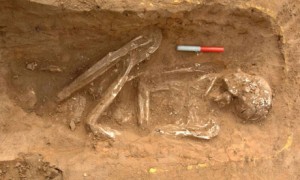Scoperto un villaggio romano nei suburbi di Londra, a Isleworth. Con una strada, sepolcri, scheletri e gioielleria. Dal Guardian de4l 217.11.2010:
Ancient Roman village discovered in parkland around stately home
Remains of a Roman road, the village and thousands of artefacts were found at Syon House in Isleworth
Maev Kennedy The Guardian, Wednesday 17 November 2010
A farming village established almost 2,000 years ago beside the Roman road leading westward out of London has been uncovered in the parkland around a stately home, now in deepest suburbia.
Extensive remains of the road and village, burials – including skeletons in ditches that are still puzzling archaeologists – and thousands of artefacts including pre-Roman jewellery were found at Syon House near the Thames in Isleworth. The mansion has been the London home of the Dukes of Northumberland for 400 years.
The finds were on the Brentford side of their land on a site being cleared for a new hotel. They were discovered only a few hundred yards from the spot where, according to passionately held local tradition, Julius Caesar crossed the Thames in 54 BC, defeating the British chieftain Cassivellaunus and his alliance of local tribes.
The haul includes pottery, a lava stone quern, coins, a dagger, jewellery including shale bangles and a gold Bronze Age bracelet, in addition to the foundations of huts and a stretch of Roman road.
The strange ditch burials, like the jewellery, may date from long before the Romans arrived, and are still being studied at the Museum of London.
The archaeological remains – described by the team from the Museum of London as “a valuable, rare insight into the daily life of an agricultural village on the outskirts of Londinium” – were only half a metre below the grass.
They were preserved in the heart of a densely built-up suburb thanks to the hundreds of acres of parkland surrounding the house. Most of the agricultural villages around the Roman city have been destroyed by later development.
The village grew up beside the road and may also have provided accommodation for travellers heading west out of the city towards Silchester – a major town near Reading that was abandoned after Roman times and never reinhabited.
The excavation was carried out two years ago, but the finds are only being revealed today. Some of the artefacts will be displayed in the new Waldorf Astoria hotel, due to open on the site later this winter.
“Syon Park has a rich and remarkable history,” said the Duke of Northumberland, who has had students from Birkbeck College digging up his back garden every summer for the past six years to reveal the outline of a vast lost medieval abbey. “The Roman findings are an incredible addition to this legacy.”


